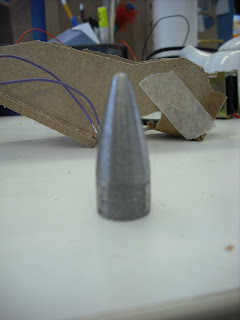As the current solenoid pin is made from metal, I decided to continue this route and make a beak from steel.
I used the metal lathe in the workshop to work the steel. It was hard to work and was slow to work. I also found that my 'beak' is a hard shape to shape and felt the metal lathe was very restricting compared to the wooden lathe. (My reasoning for this is the metal lathe forces you to turn wheels which control the tools to shape, where the wooden lathe frees you to your hands to work the tools.)
This took me a morning to complete:
 I drilled in a hole for my solenoid to fit into it in the hope it would reduce the need for fixing with glue.
I drilled in a hole for my solenoid to fit into it in the hope it would reduce the need for fixing with glue. The video shows important lessons learnt:
The video shows important lessons learnt:- weight of the material is important
- length of beak reduces sound sharpness
- attaching solenoid piston to beak
- as the beak is so small, it makes making one really difficult.
In the video, i had to lift the beak up slightly for it to be able to signal. From this i returned to the workshop and hollowed it out further and cut of around 1cm off the flat end to make it lighter. It also needed a bigger spring.
I tested it again and it worked well, producing a nice sound. This is the final metal beak:
 And this shows it working:
And this shows it working:I plan to make another beak from oak tomorrow.

No comments:
Post a Comment